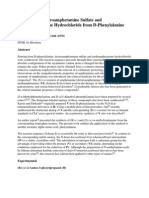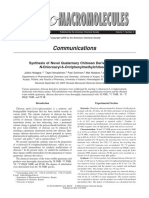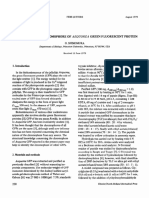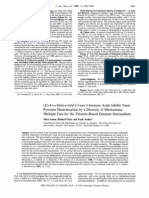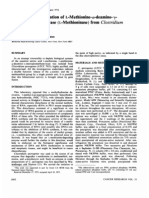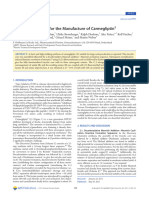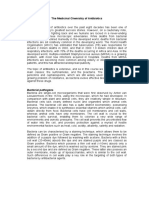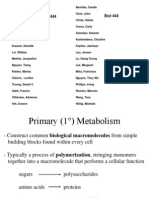Proc.
Nat.
Acad.
Sci.
USA
Vol.
72,
No.
9,
pp.
3463-3467,
September
1975
Biochemistry
Degradation
of
penicillin
G
to
phenylacetylglycine
by
D-alanine
carboxypeptidase
from
Bacillus
stearothermophilus
(gas-liquid
chromatography/mass
spectrometry/infrared
spectroscopy)
SVEN
HAMMARSTROM*
AND
JACK
L.
STROMINGER
The
Biological
Laboratories,
Harvard
University,
C
ambridge,
Massachusetts021.38
Contributed
by
Jack
L.
Strominger,July
9,
1975
ABSTRACT
D-Alaninecarboxypeptidase
from
Bacillus
stearothermophilus
is
a
membrane-bound
enzymewhich
is
inhibited
by
covalent
interaction
with
penicillin
G.
The
peni-cilloyl
enzyme
spontaneously
reactivates
and
simultaneously
releases
a
penicillin
G
degradation
product;
0.2
itmol
of
the
latter
was
isolated
after
incubation
of
4.2
gmol
of
[8.14Clpen-
icillin
G
with
10
g
of
membrane
protein.
It
was
identified
as
phenylacetylglycine
by
chromatographic
techniques,
in-
frared
spectroscopy,
and
mass
spectrometry.
A
mechanism
for
the
degradation
is
proposed
in
which
the
remaining
part
of
penicillin
G
wouldbe
released
as
5,5-dimethyl-A2-thiazo-
line-4-carboxylic
acid.
The
implications
of
this
finding
are
discussed.
Penicillins
kill
bacteria
by
inhibiting
the
crosslinking
of
pep-tidoglycan
strands
in
thebiosynthesis
of
bacterial
cell
walls.
It
has
been
proposed
that
these
antibiotics
are
structural
ana-
logs
of
the
acyl-D-alanyl-D-alanine
which
is
cleaved
by
a
transpeptidase
during
the
crosslinking
and
that
penicillins
inhibit
the
reaction
by
acylatingthe
substrate
site
of
this
en-
zyme
1).
Multiple
penicillin
binding
components
have
re-
cently
been
isolated
from
severalbacterial
strains
(reviewed
in
ref.
2).
The
major
binding
component
in
Bacillus
subtilis
and
B.
stearothermophilus
is
D-alanine
carboxypeptidase
3,4),
an
enzyme
which
catalyzes
a
reaction
analogous
to
thetranspeptidation.
In
this
reaction
water
rather
than
the
amino-group
of
a
pentaglycine
chain
serves
as
acceptor
for
the
acyl-D-alanyl
residue.
D-Alanine
carboxypeptidase
is
also
inhibited
by
penicillins
which
bind
covalently
to
the
en-
zyme
4,5).
This
binding
may
be
reversed
by
hydroxyl-
amine
or
ethanethiol
6)
or
spontaneously
7,8).
Native
pen
icilloyl-carboxypeptidase
is
required
for
the
release
reac-
tions,
suggesting
that
these
reactions
are
enzymatically
cata-
lyzed
8).
The
penicillin
derivatives
released
in
the
presence
of
hydroxylamine
or
ethanethiol
have
been
identified
6),
whereas
the
spontaneously
released
product
was
not
identi-
fied
7,8).
This
report
describesthe
identification
of
the
spontaneously
released
[8-14C]penicillin
G
degradation
product
as
phenylacetylglycine
based
on
thin-layer
and
gas-
liquid
chromatography,
infraredspectroscopy,
and
mass
spectrometry.
MATERIALS
ANDMETHODS
Chemicals.
Penicillin
G
was
generouslysupplied
by
E.
R.
Squibb
Sons
and
cephalothin
from
Eli
Lilly.
6-Aminopen-
icillanic
acid
was
obtained
fromSigma
Chemical
Co.
[8-
14C]PenicillinG,
K+-salt,
(specific
activity:
38
mCi/mmol)
was
obtained
from
Amersham-Searle.
Chloroform,
ethyl
ac-
etate,
acetone,
and
hexane
of
nanograde
quality
were
pur-
chased
from
Mallinckrodt.
Phenylacetylglycine
Methyl
Ester.
Methyl
phenylacetate
(prepared
from
phenylacetic
acid
by
HCI-methanol),
was
refluxed
for
72
hr
in
anhydrous
methanol
containing
gly-
cine,
Na+-salt
9).
The
crude
crystalline
product
[melting
point(m.p.)
140-141°;
reported
m.p.
139-141'
9)]
was
con-
verted
to
the
methyl
ester
(HCI-methanol)
and
crystallized
from
ethanol
[m.p.
87°;
reported
m.p.
86.50
10)].
The
gas-
liquid
chromatogram
(compare
Fig.
3,
mass
detectorrecord-
ing)
showed
a
single
peak
with
an
equivalentchain
length
of
C-14.4
(SE-30
column).
The
mass
spectrum
(Fig.
5,
lower
panel)
showed
intense
ions
at
mass/charge
(m/e)
207
(M+),
176
(M
-
31,
-OCH3),
148
(M
-
59,
-COOCH3),
118
(qCH=C=O)+,
116
O=C-NH-CH2COOCH3)+,
92
(C7H8)+,
91
(C7H7)+,
88
(H2N=-CH-COOCH3)+,
65
(C5H5)+,
63,56,
44,
39,
and
30.
Preparation
ofthe
[8 4C]Penicillin
G
Degradation
Product.
B.
stearothermophilus,
strain
ATCC
15952,
was
grown
as
previously
described
4).
Membranes
were
pre-
pared
by
grinding
the
cells
with
glass
beads
and
differential
centrifugation
3).
Themembranes
were
resuspended
in
0.05
M
Tris-HCl
buffer,
pH
7.5,to
a
proteinconcentrationof
20
mg/ml.
Five
hundred
milliliters
of
this
suspension
and
1
ml
cephalothin
1
mg/ml)
were
incubated
at
370
for
10
min.
After
this,
1
ml
of
[8-14C]penicillin
G
(1.5
mg
=
4.2
,gmol;
specific
activity:
3.8
mCi/mmol)
was
addedand
incu-
bation
was
continued
for
another
10
min.
The
mixture
was
thencentrifuged
at
100,000
X
g
for
1
hr,
the
pellet
was
washed
once
with
0.05
M
Tris,
pH
7.5,
resuspended
in
200
ml
of
0.01
M
sodium
cacodylate
buffer,
pH
6.5,
and
incu-
bated
at
550
for
50
min.After
addition
of
200
ml
ofwater,
thesuspension
was
centrifuged
at
100,000
X
g
for
1
hr.
The
pellet
was
discarded
and
thesupernatantsolution
was
Iyoph-
ilized.
The
residue
thus
obtained
was
dissolved
in
0.02
N
HCI
and
extractedtwice
with
ethyl
acetate.
The
combined
extracts
were
concentrated
to
dryness
in
vacuo
and
the
resi-
due
was
stored
at
-20°
(yield:
0.67
gCi-0.
18
,imol).
Part
of
the
release
product
was
treated
with
diazomethaneand
pu-
rified
by
preparative
thin-layer
chromatography
(see
below).
Stability
of
Benzylpenicilloic
Acid
at
pH
6.5
and
55°.
[8-14C]Benzylpenicilloic
acid
was
prepared
from
[8-
4C]penicillin
G
(3.8
mCi/mmol)
by
incubation
with
peni-
cillinase
(Calbiochem).
The
product
(1.6
,Ci)
was
dissolved
in
20
ml
0.01
M
sodium
cacodylate
buffer,
pH
6.5,
and
incu-
bated
at
550
for
50
min.
The
residue
after
Iyophilization
was
dissolved
in
0.02
N
HCI
and
extracted
with
ethyl
acetate.
The
extracts
were
concentrated
in
vacuo
and
aliquots
were
3463
Abbreviations:
m.p.,
melting
point;
m/e,
mass
to
charge
ratio.
*
Present
address:
Department
of
Chemistry,
Karolinska
Institutet,
S-10401
Stockholm
60,
Sweden.

3464
Biochemistry:
Hammarstrom
and
Strominger
analyzed
by
thin-layer
chromatography
before
and
after
methylation.This
showed
that
there
was
no
conversion
of
benzylpenicilloicacid
to
phenylacetylglycine
under
the
con-
ditions
used
in
the
isolation
of
the
degradation
product.
Analytical
Methods.
Melting
points
weredetermined
with
a
Thomas-Hoover
capillary
melting
point
apparatus
and
are
uncorrected.Thin-layer
chromatographywas
per-
formed
on
precoated
Silica
Gel60F-254
plates
(thickness
0.25
mm)
from
E.
Merck.
The
two
solvent
systems
used
were:
chloroform-acetone-hexane,
9:1:1
(v/v/v)
for
methyl
ester
derivatives
and
acetone-acetic
acid,
19:1(v/v)
fQr
car-
boxylic
acids
and
their
salts.
Reference
compounds
were
de-
tected
by
exposure
to
iodine
vapors;
radioactivity
was
de-tected
by
autoradiography
using
blue-sensitive
x-rayfilm
(Kodak,
SB54).
For
preparative
thin-layer
chromatography,
the
plates
weredeveloped
twice
with
ethyl
acetate
before
use.
After
chromatography,
theappropriatezones
were
scraped
off
using
a
razor
blade
and
the
compounds
were
eluted
from
the
silica
gel
with
ethyl
acetate.
AnF
M
model
400
gas
chromatograph
with
a
stream
splitter,
ahy-
drogen
flame
ionization
detector,
and
a
Packard
model
894
combustion
oven/gas
flow
counter
was
used
for
gas-liquid
radiochromatography
and
a
Perkin-Elmer
990
gas
chroma-
tograph-Hitachi
RMU
6L
mass
spectrometeroperated
on
line
with
an
IBM
1800computer
for
data
acquisition
and
processing
(11)
was
used
for
gas-liquid
chromatography-
mass
spectrometry
and
directinlet-mass
spectrometry.
The
gas
chromatograph
or
direct
inlet
effluents
were
continuous-
ly
scanned
(m/e
30
to
m/e
460)
at
4
sec
intervals.
Mass
spec-
tra
and
mass
chromatograms
were
generated
after
eachrun
by
the
computer
11).
Glass
columns
(inside
diameter
3
mm,
length
90
cm)
containing
0.75
SE-30
t
on100/140
mesh
Gas
Chrom
P
were
used
in
both
types
ofgas
chromato-
graphs.
The
mass
spectrometer
was
operated
with
an
elec-
tron
energy
of
70
eV,
a
trap
current
of
80
MA
and
an
accel-erating
voltage
of
2.2
kV.
Infrared
spectra
were
recorded
with
a
Perkin-Elmer
model
567
instrument
equipped
with
a
beam
condensor
unit.
A
Beckman
model
LS
230
liquid
scin-
tillation
spectrometer
was
used
for
radioactivity
determina-
tions.
Protein
was
determined
by
the
method
of
Lowry
et
al.
(12)
with
1
sodium
dodecyl
sulfate
added
to
reagent
A
cf.
4).
RESULTS
The
radioactive
product
released
from
[8- 4C]benzylpenicil-
loyl-D-alanine
carboxypeptidase
had
an
RF
value
of
0.54
on
silica
gel
thin-layer
chromatography
(Fig.
1,
left)
when
ace-
tone-acetic
acid,
19:1
(v/v),
was
used
as
solventsystem.
The
RF
value
was
0
when
chloroform-acetone-hexane,
9:1:1
(v/v/v)
was
used
instead.
It
changed
to
0.34
after
treatment
of
the
degradation
product
with
diazomethane,
suggestingthepresence
of
a
carboxyl
group.
The
penicillin
G
release
product
contained
substantial
amounts
of
contaminating
lip-
ids,
which
could
be
quantitatively
removed
by
preparativethin-layer
chromatography
(70-80
recovery
of
radioactivi-
ty).
After
this
step
the
methylated
release
product
was
pure
as
judged
by
thin-layer
(Fig.
1,
right)
and
gas-liquid
chro-
matography
(compare
Fig.
3
below).
TheRF
value
was
identical
to
thatof
the
methylated
release
product
before
purification.
To
ascertain
that
our
conditions
for
gas-liquid
chromatog-
raphy
would
permit
analysis
of
penicillins
and
related
com-
t
SE-30
is
a
methyl
silicone
stationary
phase
for
gas-liquid
chroma-
tography.
Rf
0-J
henylacetylglycine
henylacetylglycine;
methyl
ester
Penicillin
G,
-0.5
methyl
ester
Penicilloic
acidG,
--
dimethyl
ester
-O
FIG.
1.
Thin-layer
chromatograms
(Silica
Gel
G)
of
penicillin
G
degradation
product
(1.5
nCi)
plus
50
;ig
of
synthetic
phenyl-
acetylglycine
[solvent
system:acetone-acetic
acid,
19:1
v/v)J,
left,
and
methylated
penicillin
G
degradation
product
(2.6
nCi)
plus
100jg
of
synthetic
phenylacetylglycine
methyl
ester
[solvent
sys-
tem:
chloroform-acetone-hexane,
9:1:1
(v/v/v)],
right.
The
14C
degradationproductwas
detected
by
autoradiography
and
the
synthetic
compounds
(broken
white
lines)
by
exposure
to
iodine
vapors.
pounds,
methyl
ester
derivativesof
benzylpenicillin,
benzyl-
penicilloic
acid,
S-methyl
benzylpenicillenic
acid,
N-methyl
and
N,N-dimethyl
6-aminopenicillanic
acid
were
analyzed
by
gas-liquid
chromatography-mass
spectrometry
using
a
90
cm
0.75
SE-30
column
at
temperatures
between
130
and
200°.
These
compounds
were
all
eluted
intact
from
the
gas
chromatograph
as
shown
by
mass
spectrometry.
A
gas-liquid
radiochromatogram
of
the
methyl
ester
of
the
[8-
14C]penicillin
G,
used
to
prepare
the
release
product,
is
shown
in
Fig.
2.
The
mass
spectrum
of
the
elutedmaterial
was
identical
to
that
obtained
by
direct
probe
analysis
13).
Fig.
3
shows
a
gas-liquid
radiochromatogram
of
methylated
[8- 4C]penicillin
G
degradation
product.
The
equivalent
chain
length
was
between
C-14
and
C-15.
This
is
8-9carbon
units
less
than
the
equivalent
chain
length
of
penicillin
G
methyl
ester
(C-23.1),
suggesting
that
a
part
of
the
latter
molecule
had
been
cleaved
off
in
the
release
reaction.
An
infrared
spectrum
of
66
nmol
of
the
methylated
deg-
radation
product
pressed
into
a
micro
KBr
disk
Fig.
4,
solid
curve)
showed
two
absorption
bands
(3255
and
3080
cm- )
5~~~~~~~4
~
0
5
10
Mass0
0
0
5
10
Time(min)
FIG.
2.
Gas-liquid
radiochromatogram
of
[8-14C]penicillin
G
methyl
ester
(2.7
nCi,
25
Mg).
The
same
preparation
of
[ 4C]penicil-
lin
G,
K+-salt,
was
used
for
the
incubations.
Conditions
for
gas-
liquid
chromatography:
column
(length,
90
cm;
inside
diameter,
3
mm)
with
0.75
SE-30
on
100/140
mesh
Gas
Chrom
P;
column
temperature,
180°;
flash
heater
temperature,
2000;
carrier
gas,
N2
at
60
ml/min.
Proc.
Nat.
Acad.
Sci.
USA
72
(1975)
Biochemistry:
Hammarstrdm
and
Strominger
:3.
V0
3.3
Proc.
Nat.
Acad.
Sci.
USA
72
(1975)
3465
lb
-1-1
Rolb
q)
;:T
q
2
Q.
Time
(min)
FIG.
3.
Gas-liquid
radiochromatogram
of
methylated
penicil-
lin
G
degradation
product
(5.2
nCi)
plus
20
gg
of
synthetic
phenyl-
acetylglycine
methyl
ester.
The
conditions
for
gas-liquid
chroma-tography
werethe
same
as
those
described
in
the
legend
toFig.
2
except
thatthe
columnand
flash
heatertemperatureswere
1200
and
160°,
respectively.
in
the
N-H
stretch
region,
a
band
at
1753
cm-l
in
the
ester
carbonyl
region,
another
band
at
1641
cm-l,
and
a
band
at
1562
cm-1,
(amide
I
and
II
regions,respectively),
aromatic
C
C
absorption
at
1498
cm-l,and
C-O
ester
absorption
at
1212
cm- .
There
wasno
absorption
in
the
f3-lactam
car-
bonyl
region
(about
1780
cm- ).
The
infrared
spectrum
thus
suggested
that
the
compound
was
a
secondary
amide
with
an
ester
group
and
an
aromatic
ring.
No
evidence
for
the
presence
of
otherfunctional
groups
was
obtained
from
theinfrared
spectrum.
Mass
spectra
of
the
methylated
degradationproduct
ob-tained
by
gas-liquid
chromatography-mass
spectrometry
and
by
direct
inlet
massspectrometry
were
very
similar,
in-
dicating
that
the
methylated
release
product
was
eluted
in-
tact
from
the
gas
chromatograph.Therewereno
ions
at
m/e
174,142,
128,or
114
(Fig.
5,
upper
panel).
These
ionsare
abundant
in
the
mass
spectra
of
the
methyl
ester
derivatives
ofpenicillin
G,benzylpenicilloic
acid,
benzylpenilloic
acid,
and
N-rmethyl-6-aminopenicillanic
acid
f
and
havebeen
at-
+
S.
hammarstrom
and
J.
L.
Strominger,
unpublished
results.
50
100
150
200
250
m/e
FIG.
5.
Mass
spectra
of
methylated
[8-_4C]penicillin
G
degra-
dation
product
(upper
panel)
and
synthetic
phenylacetylglycine
methyl
ester
(lower
panel).
The
spectra
were
recorded
during
di-rect
probe
inlet
analyses
withan
electron
energyof70
eV.
tributed
by
high
resolution
mass
spectrometry
of
penicillin
G
methyl
ester
to
fragment
ions
originating
in
the
thiazoli-
dine
ring
(13).
Their
absence
in
the
massspectrum
ofthe
re-
lease
product
indicated
that
the
thiazolidine
ring
had
proba-
bly
been
eliminated,
whichwould
becompatible
with
the
retention
behavior
of
this
compound
during
gas-liquid
chro-
matography.
Ions
in
the
massspectrum
at
m/e
91
(C7H7+,
tropylium
ion)
and
m/e
118
,CH=C==O)
showed
that
the
phenacetyl
side
chain
of
penicillin
G
was
unchanged
in
the
degradation
product.
Other
ions
at
m/e
88
[H2N=CH-
COOCH3]+,
116
[O=C=
NH-CH2-COOCH3]+,
148
[0-CH2-CO-NH-CH2]+,
176
[X-CH2-CO-NH-
CH2CO]+
and
207
[W-CH2-CO-NH-CH2-
COOCH3]+
indicated
the
structure
phenylacetylglycine
methyl
ester.
Wavelength
(mim)
Wavenumber
(cm-')FIG.
4.
Infrared
spectrum
of
methylated
[8- 4C]penicillin
G
degradationproduct,
prepared
as
described
underMaterials
and
Methods
(0.25
gCi,
66
nmol),
pressed
into
micro
KBr
disk
(solid
line)
and
synthetic
phenylacetylglycine,
methyl
ester
(broken
line).
Fifty-seven
na-
nomoles
of
the
radioactive
compound
were
recovered
after
the
analysis
by
dissolvingthe
KBr
in
water
and
extracting
with
ethyl
acetate.
NO
I-0
0
_-
E
C
(0
T
3466
Biochemistry:
Hammarstrom
and
Strominger
I
Ce
HoCH2<N
2H,
N/Q
,
H
0
H
COOH
CeHsCH2CON
2
i~
COOH
nzyme
:nzyme-XH
1
3
C6H5CH2CONHCH2
3
eCX
o
x
6E1
nzyme
C6
HS
CH2
°0
3
kH20
SO
3
N CCH3
,
H
COOH
4
H20
FEnzyme-XH
C6H6CH2CONH
CH2COOH
5
C6H5CH2CONHCH2
COOH
5
FIG.
6.
Possible
mechanisms
for
the
formation
of
phenylacetyiglycine
5)
from
benzylpenicilloyl-D-alanine
carboxypeptidase
1).
Phenylacetylglycine
and
its
methyl
ester
were
synthesized
for
direct
comparison
with
the
degradation
product.
The
ra-
dioactive
penicillin
degradation
productcochromato-
graphed
with
synthetic
phenylacetylglycine
on
thin-layer
chromatography
as
the
free
acid
and
as
the
methyl
ester
(Fig.
1)
and
on
gas-liquid
chromatography
as
the
methyl
ester
(Fig.
3).
The
infrared
spectrum
of
the
methyl
ester
(Fig.
4,
broken
curve)
was
similar
to
thatof
the
methylated
degradation
product
and
the
differences
could
be
attributed
to
nonvolatile
impurities
eluted
from
the
silica
gel
during
thin-layer
chromatography.Furthermore,
the
mass
spec-
trum
of
thesynthetic
methyl
ester
(Fig.
5,
lower
panel)
was
identical
to
that
of
the
methylated
release
product.
Based
on
these
results,
the
penicillin
G
degradation
product
released
by
B.
stearothermophilus
D-alaninecarboxypeptidase
was
identified
as
phenylacetylglycine.
In
a
control
experiment,
incubation
of
[8- 4C]benzylpenicilloicacid
under
the
same
conditions
that
were
used
to
obtain
the[8- 4C]penicillin
G
release
product,there
was
no
formation
of
phenylacetylgly-
cine.
Instead,
most
of
the
penicilloic
acid
was
recovered
in-
tact.
DISCUSSION
D-Alanine
carboxypeptidases
from
B.
subtilis
(14)
and
B.
stearothermophilus
(4)
are
membrane-bound
enzymes
which
havebeen
purified
to
homogeneity
using
convention-
al
techniques
or
covalent
affinity
chromatography.
Penicil-
lin
G
inhibits
both
enzymes
by
covalent
interaction
5,4).
The
binding
ofpenicillin
G
may
involveacylation
of
an
amino-acid
residue
at
the
substrate
site
of
the
enzyme
by
the
f3-lactam
carbonyl
group
of
penicillin
[penicilloylation
1)].
Evidence
for
the
binding
of
an
intact
benzylpenicilloyl
group
has
come
from
the
identificationof
benzylpenicil-
loylhydroxamateand
a-ethanethiobenzylpenicilloate
asre-
lease
products
after
treatment
of
penicilloyl-carboxypepti-
dase
with
hydroxylamine
or
ethanethiol
6).
Preincubation
of
B.
stearothermophilus
membranes
with
cephalothin
permits
selective
binding
of
[8- 4C]penicillin
G
to
the
membrane
bound
D-alanine
carboxypeptidase
4).
The
resulting
penicilloyl-carboxypeptidase
is
readily
sepa-
rated
from
free
penicillin
G
by
two
centrifugations.
Subse-
quent
incubation
of
the
penicilloyl-enzyme
at
550
for
50
min
leads
to
release
of
about
97
of
the
radioactivity
as
a
penicillin
G
degradation
product
and
causes
reactivation
of
the
same
percentage
of
the
enzyme
8).
Similar
results
havebeen
obtained
using
purified
D-alanine
carboxypeptidase
8).
The
identificationof
this
release
product
as
phenylacetyl-
glycine
shows
that
the
spontaneous
reactivation
of
penicil-
loyl-carboxypeptidase
is
not
a
hydrolytic
removal
of
the
penicilloyl
group
from
the
enzyme.
The
latter
reaction
would
give
benzylpenicilloic
acid,
a
compound
which
was
stable
under
theconditions
used
for
the
release
reaction
and
the
isolation
of
release
product.
Thus,
unlike
a
D-alanine
car-
boxypeptidase
from
Escherichia
coli
(15),
the
corresponding
enzyme
from
B.
stearothermophilus
does
not
catalyze
a
lactamase
reaction.
The
conversion
of
penicillin
G
to
phen-
ylacetylglycine
does
not
occur
after
denaturation
of
benzyl-
penicilloyl-D-alanine
carboxypeptidase
by
severaltech-
niques,
which
suggests
that
it
is
enzymatically
catalyzed.
The
chemical
degradation
of
penicillin
G
methyl
ester
to
phenylacetylglycine
has
been
reported
(16).
It
occurs
in
tri-
fluoroacetic
acid
at
room
temperature,
probably
via
the
in-
termediate
proposed
for
the
penillic
acid
rearrangement
[(17);
see
Fig.
6,
compound
2].
Protonation
of
N-4
in
1
fol-
lowed
by
fragmentation
between
C-5and
C-6
gave
2-ben-
zyl-2-oxazolin-5-one
andmethyl
D-5,5-dimethyl-A2-thiazo-
line-4-carboxylate
(Fig.
6,
3
and
the
methyl
ester
of
4,
respectively).
3
is
unstable
and
undergoes
rapid
hydrolysis
to
5,
phenylacetylglycine,
in
aqueous
solutions
(18).
The
degra-
dation
of
penicillin
G
to
phenylacetylglycine
by
D-alanine
carboxypeptidase
may
follow
a
similar
mechanism.
Two
possibilities
are
outlined
in
Fig.
6.
In
pathway
I,
the
forma-
tion
of
2
from
benzylpenicilloyl
carboxypeptidase,
1,
is
anal-
ogous
to
the
formation
of
2
from
penicillin
G
(17).
Although
formation
of
2
leads
to
scission
of
the
penicilloyl-enzyme
bond
2
may
remain
tightly
bound
to
the
enzyme
by
nonco-
valent
forces
until
fragmentation
into
3
and
4
has
occurred.
Alternatively
(pathway
II),
the
enzyme
may
activate
the
penicilloylresidue
for
cleavage
without
the
necessityfor
for-
mation
of
2.
In
this
mechanism
phenylacetylglycyl
enzyme,
6,
would
be
an
intermediate.
S
CH3
r
[CH3
N
/
H
COOH
4
Proc.
Nat.
Acad.
Sci.
USA
72
(1975)
w


